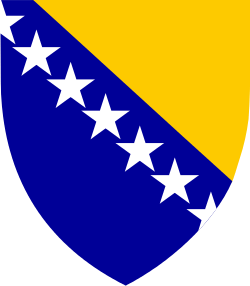Demographics of Bosnia and Herzegovina

This article is about the demographic features of the population of Bosnia and Herzegovina, including population density, ethnicity, education level, health of the populace, economic status, religious affiliations and other aspects of the population.
Vital statistics
| [1][2][3] | Average population (x 1000) | Live births | Deaths | Natural change | Crude birth rate (per 1000) | Crude death rate (per 1000) | Natural change (per 1000) | Total fertility rate | Infant mortality rate (per 1000 births) | Life expectancy males | Life expectancy females |
|---|---|---|---|---|---|---|---|---|---|---|---|
| 1947 | 2 532 | 84 600 | 38 900 | 45 700 | 33.4 | 15.4 | 18.0 | ||||
| 1948 | 2 586 | 90 700 | 41 600 | 49 100 | 35.1 | 16.1 | 19.0 | ||||
| 1949 | 2 642 | 98 200 | 42 200 | 56 000 | 37.2 | 16.0 | 21.2 | ||||
| 1950 | 2 661 | 102 680 | 35 991 | 66 689 | 38.6 | 13.5 | 25.1 | ||||
| 1951 | 2 721 | 92 330 | 46 358 | 45 972 | 33.9 | 17.0 | 16.9 | ||||
| 1952 | 2 779 | 112 216 | 34 817 | 77 399 | 40.4 | 12.5 | 27.9 | ||||
| 1953 | 2 836 | 110 373 | 41 199 | 69 174 | 38.9 | 14.5 | 24.4 | ||||
| 1954 | 2 891 | 115 854 | 35 158 | 80 696 | 40.1 | 12.2 | 27.9 | ||||
| 1955 | 2 944 | 110 866 | 40 513 | 70 353 | 37.7 | 13.8 | 23.9 | ||||
| 1956 | 2 994 | 111 561 | 38 320 | 73 241 | 37.3 | 12.8 | 24.5 | ||||
| 1957 | 3 042 | 102 649 | 36 830 | 65 819 | 33.7 | 12.1 | 21.6 | ||||
| 1958 | 3 089 | 110 332 | 30 123 | 80 209 | 35.7 | 9.8 | 26.0 | ||||
| 1959 | 3 135 | 108 123 | 32 507 | 75 616 | 34.5 | 10.4 | 24.1 | ||||
| 1960 | 3 180 | 110 499 | 33 360 | 77 139 | 34.7 | 10.5 | 24.3 | ||||
| 1961 | 3 225 | 108 076 | 29 413 | 78 663 | 33.5 | 9.1 | 24.4 | ||||
| 1962 | 3 271 | 106 826 | 31 087 | 75 739 | 32.7 | 9.5 | 23.2 | ||||
| 1963 | 3 315 | 104 240 | 29 161 | 75 079 | 31.4 | 8.8 | 22.6 | ||||
| 1964 | 3 357 | 101 147 | 29 846 | 71 301 | 30.1 | 8.9 | 21.2 | ||||
| 1965 | 3 396 | 101 351 | 27 814 | 73 537 | 29.8 | 8.2 | 21.7 | ||||
| 1966 | 3 433 | 97 689 | 25 138 | 72 551 | 28.5 | 7.3 | 21.1 | ||||
| 1967 | 3 466 | 92 972 | 26 195 | 66 777 | 26.8 | 7.6 | 19.3 | ||||
| 1968 | 3 498 | 89 134 | 26 031 | 63 103 | 25.5 | 7.4 | 18.0 | ||||
| 1969 | 3 531 | 87 687 | 27 805 | 59 882 | 24.8 | 7.9 | 17.0 | ||||
| 1970 | 3 564 | 79 296 | 26 355 | 52 941 | 22.2 | 7.4 | 14.9 | ||||
| 1971 | 3 600 | 82 694 | 24 915 | 57 779 | 23.0 | 6.9 | 16.0 | ||||
| 1972 | 3 637 | 82 068 | 26 844 | 55 224 | 22.6 | 7.4 | 15.2 | ||||
| 1973 | 3 675 | 77 896 | 24 672 | 53 224 | 21.2 | 6.7 | 14.5 | ||||
| 1974 | 3 712 | 77 833 | 23 661 | 54 172 | 21.0 | 6.4 | 14.6 | ||||
| 1975 | 3 747 | 78 844 | 25 571 | 53 273 | 21.0 | 6.8 | 14.2 | ||||
| 1976 | 3 781 | 79 061 | 25 178 | 53 883 | 20.9 | 6.7 | 14.3 | ||||
| 1977 | 3 813 | 75 669 | 24 821 | 50 848 | 19.8 | 6.5 | 13.3 | ||||
| 1978 | 3 844 | 73 306 | 26 016 | 47 290 | 19.1 | 6.8 | 12.3 | ||||
| 1979 | 3 878 | 71 120 | 25 370 | 45 750 | 18.3 | 6.5 | 11.8 | ||||
| 1980 | 3 914 | 70 928 | 26 115 | 44 813 | 18.1 | 6.7 | 11.4 | ||||
| 1981 | 3 950 | 71 031 | 26 222 | 44 809 | 18.0 | 6.6 | 11.3 | ||||
| 1982 | 3 986 | 73 375 | 26 775 | 46 600 | 18.4 | 6.7 | 11.7 | ||||
| 1983 | 4 025 | 74 296 | 29 999 | 44 297 | 18.5 | 7.5 | 11.0 | ||||
| 1984 | 4 070 | 74 539 | 29 046 | 45 493 | 18.3 | 7.1 | 11.2 | ||||
| 1985 | 4 122 | 72 722 | 28 966 | 43 756 | 17.6 | 7.0 | 10.6 | ||||
| 1986 | 4 189 | 71 203 | 29 127 | 42 076 | 17.0 | 7.0 | 10.0 | ||||
| 1987 | 4 267 | 70 898 | 29 382 | 41 516 | 16.6 | 6.9 | 9.7 | ||||
| 1988 | 4 332 | 70 711 | 29 559 | 41 152 | 16.3 | 6.8 | 9.5 | ||||
| 1989 | 4 353 | 66 809 | 30 383 | 36 426 | 15.3 | 7.0 | 8.4 | ||||
| 1990 | 4 308 | 66 952 | 29 093 | 37 859 | 15.5 | 6.8 | 8.8 | ||||
| 1991 | 4 163 | 64 769 | 31 411 | 33 358 | 15.6 | 7.5 | 8.0 | ||||
| 1992 | |||||||||||
| 1993 | |||||||||||
| 1994 | |||||||||||
| 1995 | |||||||||||
| 1996 | 3 645 | 46 594 | 25 152 | 21 442 | 12.8 | 6.9 | 5.9 | 1.65 | |||
| 1997 | 3 738 | 48 397 | 27 875 | 20 522 | 12.9 | 7.5 | 5.5 | 1.68 | |||
| 1998 | 3 653 | 45 007 | 28 679 | 16 328 | 12.3 | 7.9 | 4.5 | 1.56 | |||
| 1999 | 3 725 | 42 464 | 28 637 | 13 827 | 11.4 | 7.7 | 3.7 | 1.36 | |||
| 2000 | 3 781 | 39 563 | 30 482 | 9 081 | 10.5 | 8.1 | 2.4 | 1.30 | |||
| 2001 | 3 798 | 37 717 | 30 325 | 7 392 | 9.9 | 8.0 | 1.9 | 1.40 | |||
| 2002 | 3 828 | 35 587 | 30 155 | 5 432 | 9.3 | 7.9 | 1.4 | 1.20 | |||
| 2003 | 3 833 | 35 234 | 31 757 | 3 477 | 9.2 | 8.3 | 0.9 | 1.22 | |||
| 2004 | 3 843 | 35 151 | 32 616 | 2 535 | 9.2 | 8.5 | 0.7 | 1.22 | |||
| 2005 | 3 843 | 34 627 | 34 402 | 225 | 9.0 | 9.0 | 0.1 | 1.20 | |||
| 2006 | 3 843 | 34 033 | 33 221 | 812 | 8.9 | 8.6 | 0.2 | 1.18 | |||
| 2007 | 3 843 | 33 835 | 35 044 | -1 209 | 8.8 | 9.1 | -0.3 | 1.26 | |||
| 2008 | 3 842 | 34 176 | 34 026 | 150 | 8.9 | 8.9 | 0.0 | 1.29 | |||
| 2009 | 3 843 | 34 617 | 33 983 | 634 | 9.0 | 9.0 | 0.0 | 1.30 | |||
| 2010 | 3 843 | 33 820 | 34 772 | 48 | 8.8 | 8.8 | 0.0 | 1.27 | |||
| 2011 | 3 840 | 33 779 | 34 633 | -854 | 8.8 | 9.0 | -0.2 | 1.21 | |||
| 2012 | 3 836 | 31 875 | 35 522 | -3 647 | 8.3 | 9.3 | -1.0 | 1.349 | |||
| 2013 | 3 791 | 32 072 | 35 629 | -3 620 | 8.5 | 9.5 | -1.0 | 1.276 | |||
| 2014 | 3 786 | 31 103 | 35 837 | -4 734 | 8.2 | 9.5 | -1.3 | 1.258 | |||
| 2015 | 3 777 | 28 906 | 37 070 | -8 164 | 7.6 | 9.7 | - 2.1 | ||||
| 2016 JJ | 3 777 | 13 278 | 18 016 | -4 738 |
- JJ = 1.1.2016 - 30.6.2016
Ethnic groups
According to data from 2013 census published by the Agency for Statistics of Bosnia and Herzegovina, Bosniaks constitute 50.11% of the population, Bosnian Serbs 30.78%, Bosnian Croats 15.43%, and others form 2.73%, with the remaining respondents not declaring their ethnicity or not answering.[4] The census results are contested by the Republika Srpska statistical office and by Bosnian Serb politicians,[5] who oppose the inclusion of non-permanent Bosnian residents in the figures.[6] The European Union's statistics office, Eurostat, however concluded the methodology used by the Bosnian statistical agency to be in line with international recommendations.[7]
In Bosnia and Herzegovina, religion is often linked to ethnicity, i.e. (with the exception of agnostics and atheists) most Bosniaks are Muslim, Serbs are Orthodox Christian, and Croats are Roman Catholic.
| Ethnic group |
census 1948 | census 1953 | census 1961 | census 1971 | census 1981 | census 1991 | census UNHCR 1996 | census 2013 | popul.change 1991-2013 | |||||||||
|---|---|---|---|---|---|---|---|---|---|---|---|---|---|---|---|---|---|---|
| Number | % | Number | % | Number | % | Number | % | Number | % | Number | % | Number | % | Number | % | Number | % | |
| Bosniaks | 788,403 | 30.7 | 891,800 | 31.3 | 842,248 | 25.7 | 1,482,430 | 39.6 | 1,629,924 | 39.5 | 1,902,956 | 43.5 | 1,805,910 | 46.1 | 1,769,592 | 50.11 | -133,364 | +6.64% |
| Serbs | 1,136,116 | 44.3 | 1,264,372 | 44.4 | 1,406,057 | 42.9 | 1,393,148 | 37.2 | 1,320,644 | 32.0 | 1,366,104 | 31.2 | 1,484,530 | 37.9 | 1,086,733 | 30.78 | -279,371 | -0.43% |
| Croats | 614,123 | 23.9 | 654,229 | 23.0 | 711,665 | 21.7 | 772,491 | 20.6 | 758,136 | 18.4 | 760,852 | 17.4 | 571,317 | 14.6 | 544,780 | 15.43 | -216,072 | -1.95% |
| Yugoslavs | 275,883 | 8.4 | 43,796 | 1.2 | 326,280 | 7.9 | 242,682 | 5.5 | ||||||||||
| Montenegrins | 3,094 | 0.1 | 7,336 | 0.3 | 12,828 | 0.4 | 13,021 | 0.3 | 14,114 | 0.3 | 10,071 | 0.2 | ||||||
| Roma | 442 | 0.0 | 2,297 | 0.1 | 588 | 0.0 | 1,456 | 0.0 | 7,251 | 0.2 | 8,864 | 0.2 | ||||||
| Albanians | 3,642 | 0.1 | 3,764 | 0.1 | 4,396 | 0.1 | 4,925 | 0.1 | ||||||||||
| Others/undeclared | 23,099 | 0.9 | 27,756 | 1.0 | 28,679 | 0.8 | 36,005 | 1 | 63,263 | 1.5 | 80,579 | 1.9 | 58,196 | 1.5 | 130,054 | 3.62 | ||
| Total | 2,565,277 | 2,847,790 | 3,277,948 | 3,746,111 | 4,124,008 | 4,376,403 | 3,919,953 | 3,531,159 | ||||||||||
 Ethnic structure of Bosnia and Herzegovina by municipalities in 2013
Ethnic structure of Bosnia and Herzegovina by municipalities in 2013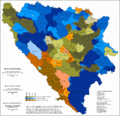 Ethnic structure of Bosnia and Herzegovina by municipalities in 2013
Ethnic structure of Bosnia and Herzegovina by municipalities in 2013 Share of Bosniaks in Bosnia and Herzegovina by municipalities in 2013
Share of Bosniaks in Bosnia and Herzegovina by municipalities in 2013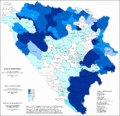 Share of Serbs in Bosnia and Herzegovina by municipalities in 2013
Share of Serbs in Bosnia and Herzegovina by municipalities in 2013 Share of Croats in Bosnia and Herzegovina by municipalities in 2013
Share of Croats in Bosnia and Herzegovina by municipalities in 2013
Languages
Bosnia's constitution does not specify any official languages.[8][9][10] However, academics Hilary Footitt and Michael Kelly note that the Dayton Agreement states that it is "done in Bosnian, Croatian, English and Serbian", and they describe this as the "de facto recognition of three official languages" at the state level. The equal status of Bosnian, Serbian and Croatian was verified by the Constitutional Court in 2000.[10] It ruled that the provisions of the Federation and Republika Srpska constitutions on language were incompatible with the state constitution, since they only recognised "Bosniak" and Croatian (in the case of the Federation) and Serbian (in the case of Republika Srpska) as official languages at the entity level. As a result, the wording of the entity constitutions was changed and all three languages were made official in both entities.[10] The three languages are mutually intelligible and were previously known collectively as Serbo-Croatian. Use of one of the three languages has become a marker of ethnic identity.[11] Michael Kelly and Catherine Baker argue: "The three official languages of today's Bosnian state...represent the symbolic assertion of national identity over the pragmatism of mutual intelligibility".[12] All standard varieties are based on the Ijekavian varieties of the Shtokavian dialect (non-standard spoken varieties including, beside Ijekavian, also Ikavian Shtokavian). Bosnian and Serbian are written in both Latin and Cyrillic, whereas Croatian is written only in a Latin alphabet. There are also minor speakers of Italian, German, Turkish and Ladino. Yugoslav Sign Language is used with Croatian and Serbian variants.
According to the results of the 2013 census, 52.86% of the population consider their mother tongue to be Bosnian, 30.76% Serbian, 14.6% Croatian and 1.57% another language, with 0.21% not giving an answer.[4]
 Linguistic structure of Bosnia and Herzegovina by municipalities in 2013
Linguistic structure of Bosnia and Herzegovina by municipalities in 2013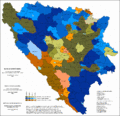 Linguistic structure of Bosnia and Herzegovina by municipalities in 2013
Linguistic structure of Bosnia and Herzegovina by municipalities in 2013 Share of the Bosnian language in Bosnia and Herzegovina by municipalities in 2013
Share of the Bosnian language in Bosnia and Herzegovina by municipalities in 2013 Share of the Serbian language in Bosnia and Herzegovina by municipalities in 2013
Share of the Serbian language in Bosnia and Herzegovina by municipalities in 2013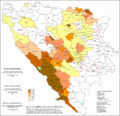 Share of the Croatian language in Bosnia and Herzegovina by municipalities in 2013
Share of the Croatian language in Bosnia and Herzegovina by municipalities in 2013
Religion
According to the 2013 census, 50.7% of the population identify religiously as Muslim, 30.75% as Serbian Orthodox Christian, 15.19% as Roman Catholic, 1.15% as other, 1.1% as agnostic or atheist, with the remainder not declaring their religion or not answering.[4] A 2012 survey found that 54% of Bosnia's Muslims are non-denominational Muslims, while 38% follow Sunnism.[13] In Bosnia and Herzegovina religion is tied to ethnic belonging. With the exception of agnostics and atheists, all Bosniaks are Muslims, Serbs are Orthodox Christians, and Croats are Roman Catholic.
 Religious structure of Bosnia and Herzegovina by municipalities in 2013
Religious structure of Bosnia and Herzegovina by municipalities in 2013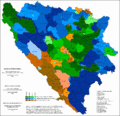 Religious structure of Bosnia and Herzegovina by municipalities in 2013
Religious structure of Bosnia and Herzegovina by municipalities in 2013 Share of Muslims in Bosnia and Herzegovina by municipalities in 2013
Share of Muslims in Bosnia and Herzegovina by municipalities in 2013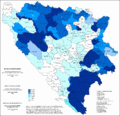 Share of Orthodox Christians in Bosnia and Herzegovina by municipalities in 2013
Share of Orthodox Christians in Bosnia and Herzegovina by municipalities in 2013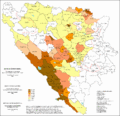 Share of Catholics in Bosnia and Herzegovina by municipalities in 2013
Share of Catholics in Bosnia and Herzegovina by municipalities in 2013
CIA World Factbook demographic statistics
The following demographic statistics are from the CIA World Factbook, unless otherwise indicated.
Population
- 3,871,643 (July 2014 est.)
Age structure
- 0-14 years: 13.7% (male 272,812/female 256,152)
- 15-24 years: 12.7% (male 255,074/female 238,428)
- 25-54 years: 46.7% (male 906,265/female 899,870)
- 55-64 years: 13.7% (male 253,045/female 276,769)
- 65 years and over: 13.3% (male 199,515/female 313,713) (2014 est.)
Median age
- Total: 40.8 years
- Male: 39.4 years
- Female: 42.2 years (2014 est.)
Sex ratio
- At birth: 1.07 male(s)/female
- 0-14 years: 1.07 male(s)/female
- 15-24 years: 1.07 male(s)/female
- 25-54 years: 1.01 male(s)/female
- 55-64 years: 0.95 male(s)/female
- 65 years and over: 0.63 male(s)/female
- Total population: 0.95 male(s)/female (2014 est.)
Infant mortality rate
- Total: 5.84 deaths/1,000 live births
- Male: 5.91 deaths/1,000 live births
- Female: 5.78 deaths/1,000 live births (2014 est.)
Life expectancy at birth
- Total population: 76.33 years
- Male: 73.33 years
- Female: 79.55 years (2014 est.)
HIV/AIDS
- Adult prevalence rate: less than 0.1% (2007 est.)
- People living with HIV/AIDS: 900 (2007 est.)
- Deaths: 100 (2001 est.)
Literacy
- Definition: age 15 and over can read and write
- Total population: 98%
- Male: 99.5%
- Female: 96.7% (2011 est.)
See also
- Demographic history of Bosnia and Herzegovina
- Bosnia and Herzegovina
- List of Bosnians and Herzegovinians
Religion:
- Islam in Bosnia and Herzegovina
- Serbian Orthodox Church
- Roman Catholicism in Bosnia and Herzegovina
- Jews in Bosnia and Herzegovina
Groups:
References
- ↑ Institut national d'études démographique (INED)
- ↑ Agency for Statistics Bosnia and Herzegovina
- ↑ http://www.bhas.ba/tematskibilteni/BHAS_Demografija_BH.pdf
- 1 2 3 "Census of population, households and dwellings in Bosnia and Herzegovina, 2013: Final results" (PDF). Agency for Statistics of Bosnia and Herzegovina. June 2016. Retrieved 1 July 2016.
- ↑ Toe, Rodolfo (30 June 2016). "Census Reveals Bosnia's Changed Demography". Balkan Insight. Retrieved 1 July 2016.
- ↑ Toe, Rodolfo (30 June 2016). "Bosnia to Publish Census Without Serb Agreement". Balkan Insight. Retrieved 1 July 2016.
- ↑ "Bosnia-Herzegovina has lost a fifth of its pre-war population". The Guardian. 2016.
- ↑ Faingold, Eduardo D. (2004). "Language rights and language justice in the constitutions of the world". Language Problems & Language Planning. 28 (1): 11–24. doi:10.1075/lplp.28.1.03fai.
- ↑ Sadurski, Wojciech (2005). Rights Before Courts: A Study of Constitutional Courts in Postcommunist States of Central and Eastern Europe. Springer. p. 342. ISBN 1402030061.
- 1 2 3 Footitt, Hilary; Kelly, Michael (2012). Languages at War: Policies and Practices of Language Contacts in Conflict. Basingstoke: Palgrave Macmillan. pp. 111–120. ISBN 0230368778.
- ↑ Greenberg, Robert David (2004). Language and Identity in the Balkans: Serbo-Croatian and its Disintegration. Oxford: Oxford University Press. ISBN 978-0-19-925815-4.
- ↑ Kelly, Michael; Baker, Catherine (2013). Interpreting the Peace: Peace Operations, Conflict and Language in Bosnia-Herzegovina. Basingstoke: Palgrave Macmillan. p. 10. ISBN 1137029838.
- ↑ "The World's Muslims: Unity and Diversity" (PDF). Pew Research Center. 2012. p. 30. Retrieved 7 April 2016.
![]() This article incorporates public domain material from the CIA World Factbook document "2009 edition".
This article incorporates public domain material from the CIA World Factbook document "2009 edition".
External links
| Wikimedia Commons has media related to Demographics of Bosnia and Herzegovina. |
